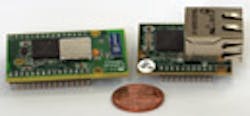San Jose, Calif. embedded device developer Connect One unveiled the Nano Socket family of embedded local area network (LAN) and WiFi modules--the Nano Socket iWiFi and Nano Socket LAN. The Nano Socket iWiFi/LAN modules are based on its CO2144 Internet Controller and targets machine-to-machine (M2M) solutions. Nano Socket iWiFi is an 802.11b/g embedded WiFi module with an integrated WiFi antenna. Nano Socket LAN is a 10/100BaseT LAN module with an integrated RJ45 connector.
The devices add full-featured Internet access functionality over LAN or WiFi to an embedded device, including TCP sockets, SSL encryption, routing, e-mail, and file transfers. The logical interface between the host application and the modules is Connect One’s AT+i Protocol, a simple text-based API that enables fast and easy implementation of Internet networking and security protocols.
As part of the security features, the modules serve as a communications offload engine and inherent firewall, protecting the embedded device from the Internet attacks. Both modules boast high level of Internet security and encryption algorithms (AES-128/256, SHA-128/192/256, 3DES, SSL3/TLS1 protocol for a secure client socket session) for complete, end-to-end encryption support. The Nano Socket iWiFi also includes the latest WLAN encryption schemes (64/128-bit WEP, WPA/WPA2 enterprise).
Both modules share the same simple header-based pinout, allowing customers reduced assembly costs and increased flexibility when designing solutions. A single product design can easily accommodate both LAN and WiFi.
The modules support several modes of operation:
- Serial-to-LAN/WiFi Bridge--transparent bridging of serial data over LAN or WiFi
- LAN-to-WiFi Bridge--transparent bridging of LAN over WiFi using direct RMII connection to existing MAC hardware. Full Internet Controller mode--allowing simple microcontrollers to perform complex Internet operations such as e-mail, FTP, SSL, and others.
- PPP emulation--offering existing (e.g., cellular modem) designs currently using PPP to interface to the cellular modem by connecting transparently over LAN or WiFi with no changes to application or drivers
Large-volume customers can build a chip-level solution identical to the Nano SocketLAN family functionality by adding an iChip CO2144/2128 and the relevant PHY to the main PCB. Customers can benefit from quick time to market afforded by the modules, and later migrate to a lower cost, chip-based solution and realize significant cost savings. Reference designs outlining the transition can be downloaded from Connect One’s website.
"We designed the Nano Socket module family for customers interested in a simple solution to add LAN or WiFi connectivity to their devices," noted Ariel Shulman, Connect One vice president of sales. "The shared form factor and onboard antenna or LAN connector enables customers to release their products quickly and reliably, while reducing development and maintenance costs."
The Nano Socket family eases development by including USB, SPI, USART and RMII interfaces. The Nano Socket LAN operates at an industrial temperature range of -40° to 85° C (-40° to 185° F) and is RoHS-compliant.
About the Author
Gary Mintchell
Editor in Chief

Leaders relevant to this article:
